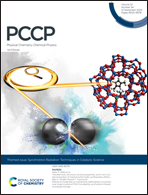Electroresponsive structuring and friction of a non-halogenated ionic liquid in a polar solvent: effect of concentration†
Abstract
Neutron reflectivity (NR) measurements have been employed to study the interfacial structuring and composition of electroresponsive boundary layers formed by an ionic liquid (IL) lubricant at an electrified gold interface when dispersed in a polar solvent. The results reveal that both the composition and extent of the IL boundary layers intricately depend on the bulk IL concentration and the applied surface potential. At the lowest concentration (5% w/w), a preferential adsorption of the IL cation at the gold electrode is observed, which hinders the ability to electro-induce changes in the boundary layers. In contrast, at higher IL bulk concentrations (10 and 20% w/w), the NR results reveal a significantly larger concentration of the IL ions at the gold interface that exhibit significantly greater electroresponsivity, with clear changes in the layer composition and layer thickness observed for different potentials. In complementary atomic force microscopy (AFM) measurements on an electrified gold surface, such IL boundary layers are demonstrated to provide excellent friction reduction and electroactive friction (known as tribotronics). In agreement with the NR results obtained, clear concentration effects are also observed. Together such results provide valuable molecular insight into the electroactive structuring of ILs in solvent mixtures, as well as provide mechanistic understanding of their tribotronic behaviours.



 Please wait while we load your content...
Please wait while we load your content...